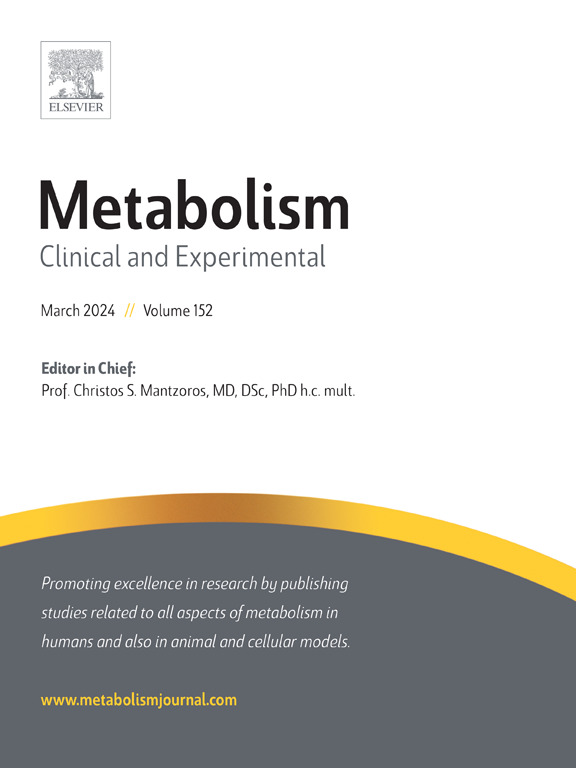增强心脏丝氨酸生物合成可减轻扩张型心肌病的进展。
IF 11.9
1区 医学
Q1 ENDOCRINOLOGY & METABOLISM
引用次数: 0
摘要
遗传性扩张型心肌病(DCM)是心力衰竭的主要原因。然而,疾病改善疗法仍然有限。代谢功能障碍已成为DCM发病机制的关键驱动因素,而由限速酶磷酸甘油脱氢酶(PHGDH)催化的丝氨酸生物合成受损,最近已被确定为潜在的治疗靶点。在此,我们通过aav9介导的PHGDH基因增强,在具有既定病理的转基因TM54小鼠DCM模型中评估了增加丝氨酸生物合成的治疗潜力。纵向超声心动图显示,与AAV9-GFP对照组相比,AAV9-PHGDH治疗TM54小鼠的收缩功能得到保留,心室扩张得到抑制。组织学分析显示,aav9 - phgdh处理的TM54心脏心肌纤维化和心肌细胞肥大减少,表明病理性重构逆转。代谢分析,包括靶向代谢组学和体内13c -葡萄糖示踪分析,显示AAV9-PHGDH处理心脏的丝氨酸水平升高,同时葡萄糖衍生的丙酮酸和乳酸降低。同时,线粒体氧化代谢保持完整,表明糖酵解碳向丝氨酸生物合成转移。总之,这些研究结果表明,通过PHGDH基因增强治疗增强心脏丝氨酸合成可以保持收缩功能并减轻体内疾病进展,这为DCM提供了一种新的代谢治疗策略。本文章由计算机程序翻译,如有差异,请以英文原文为准。
Enhancing cardiac serine biosynthesis mitigates the progression of dilated cardiomyopathy in mice
Genetic dilated cardiomyopathy (DCM) is a leading cause of heart failure. However, disease-modifying therapies remain limited. Metabolic dysfunction has emerged as a key driver of DCM pathogenesis, and impaired serine biosynthesis, catalyzed by the rate-limiting enzyme phosphoglycerate dehydrogenase (PHGDH), has recently been identified as a potential therapeutic target. Here, we evaluated the therapeutic potential of increasing serine biosynthesis through AAV9-mediated PHGDH gene augmentation in a transgenic TM54 mouse model of DCM with established pathology. Longitudinal echocardiography showed preserved systolic function and prevented ventricular dilatation in TM54 mice treated with AAV9-PHGDH compared to AAV9-GFP controls. Histological analysis revealed reduced myocardial fibrosis and cardiomyocyte hypertrophy in AAV9-PHGDH-treated TM54 hearts, indicating a reversal of pathological remodeling. Metabolic profiling, including targeted metabolomics and in vivo 13C-glucose tracing analysis, revealed that serine levels increased in hearts treated with AAV9-PHGDH, accompanied by decreases in glucose-derived pyruvate and lactate. At the same time, mitochondrial oxidative metabolism remained intact, indicating a shift of glycolytic carbon towards serine biosynthesis. Collectively, these findings show that enhancing cardiac serine synthesis through PHGDH gene augmentation therapy preserves contractile function and mitigates disease progression in vivo, suggesting a novel metabolic therapeutic strategy for DCM.
求助全文
通过发布文献求助,成功后即可免费获取论文全文。
去求助
来源期刊

Metabolism: clinical and experimental
医学-内分泌学与代谢
CiteScore
18.90
自引率
3.10%
发文量
310
审稿时长
16 days
期刊介绍:
Metabolism upholds research excellence by disseminating high-quality original research, reviews, editorials, and commentaries covering all facets of human metabolism.
Consideration for publication in Metabolism extends to studies in humans, animal, and cellular models, with a particular emphasis on work demonstrating strong translational potential.
The journal addresses a range of topics, including:
- Energy Expenditure and Obesity
- Metabolic Syndrome, Prediabetes, and Diabetes
- Nutrition, Exercise, and the Environment
- Genetics and Genomics, Proteomics, and Metabolomics
- Carbohydrate, Lipid, and Protein Metabolism
- Endocrinology and Hypertension
- Mineral and Bone Metabolism
- Cardiovascular Diseases and Malignancies
- Inflammation in metabolism and immunometabolism
 求助内容:
求助内容: 应助结果提醒方式:
应助结果提醒方式:


